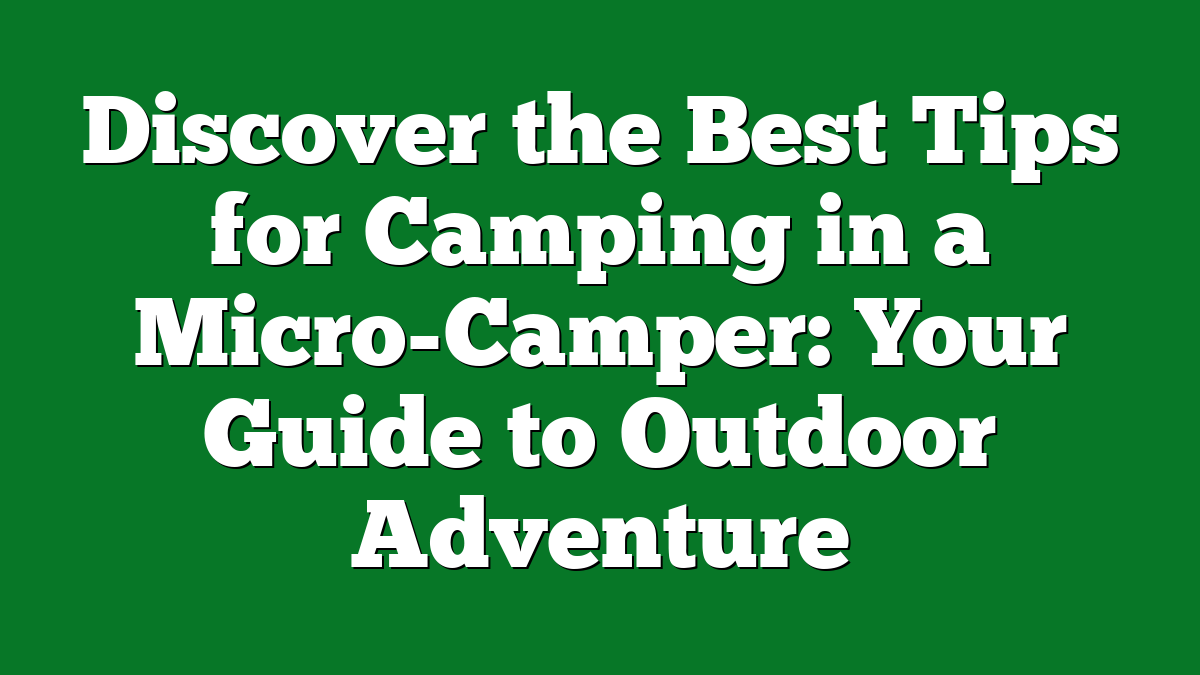There’s something magical about hitting the open road in a micro-camper. Whether you’re a seasoned adventurer or just starting out, these compact homes on wheels offer a unique way to experience the great outdoors. I love the freedom and flexibility they provide, allowing me to explore hidden gems without the hassle of traditional camping setups.
Preparing for Your Micro-Camping Trip
Preparing for a micro-camping trip involves careful planning to make the most of your adventure. Choosing the right location and packing essentials ensures a smooth experience in the great outdoors.
Choosing the Right Location
Choosing a prime location sets the tone for your trip. I often consider these factors:
- Proximity to Nature: Select sites near hiking trails, lakes, or rivers for easy access to activities such as fishing and swimming.
- Amenities Available: Look for campsites with basic facilities like restrooms, fresh water, and picnic areas for comfort.
- Terrain Accessibility: Evaluate the terrain. Flat, stable ground works best for parking and setting up the micro-camper.
- Safety Considerations: Assess proximity to wildlife habitats. Ensure safety measures are in place to avoid surprises, particularly during night hours.
- Regulations and Restrictions: Research local camping regulations. Some areas require permits or have specific rules regarding campfires and vehicle access.
Essentials to Pack
Packing the right essentials makes micro-camping enjoyable and efficient. My packing list includes:
- Cooking Gear: Bring a portable stove, utensils, and lightweight cookware to prepare meals.
- Sleeping Equipment: Pack a quality sleeping bag, air mattress, or hammock for a comfortable night’s sleep.
- Clothing Layers: Prepare for changing weather with moisture-wicking base layers, an insulating mid-layer, and a waterproof outer layer.
- First Aid Kit: Include items like band-aids, antiseptic wipes, and pain relievers to address minor injuries or illnesses.
- Navigation Tools: Carry a map, compass, or GPS device to stay oriented and explore new trails confidently.
- Water Filtration: Include a reliable water filter or purification tablets, ensuring safe drinking water during your trip.
- Lighting Solutions: Bring a headlamp or rechargeable lantern for visibility at night without consuming too much space.
These steps help create a memorable micro-camping experience, allowing me to fully enjoy the tranquility of nature.
Maximizing Space in a Micro-Camper
Maximizing space in a micro-camper transforms it into a cozy, functional living area. With a bit of strategy, I create an organized and efficient setup that enhances my outdoor experience.
Organizing Your Gear
Organizing gear efficiently starts with categorizing items. I use storage bins or compact bag systems for kitchen gear, clothing, and outdoor tools. Stacking and securing bins under benches or beds reduces clutter. Using vertical space, I hang lightweight items like pots or utensils from hooks. Drawer dividers keep small essentials sorted, making it easy to find what I need quickly. I ensure my gear’s accessibility for comfortable living, especially during unpredictable weather or late-night cooking.
Multi-Functional Furniture
Multi-functional furniture maximizes utility without sacrificing comfort. I opt for foldable tables that serve as dining surfaces and workspaces. Bench seating often doubles as storage, housing extra blankets or cooking essentials. A Murphy bed or convertible couch provides sleeping space while maintaining a relaxed seating area. Additionally, utilizing ottomans that open for storage helps keep my essentials organized and within reach. Each piece of furniture increases my micro-camper’s practicality, allowing me to enjoy both comfort and efficiency on my adventures.
Cooking and Dining in a Micro-Camper
Cooking in a micro-camper takes a bit of creativity, but it can be just as gratifying as cooking in a traditional kitchen. With some planning and the right tools, I can whip up delicious meals even in tight spaces.
Efficient Meal Planning
Efficient meal planning transforms my camping experience. I pack simple, versatile ingredients that cater to various dishes. For example:
- Proteins: I choose chicken, beef, or plant-based options like beans for easy cooking.
- Fruits and Vegetables: I pack hardy vegetables like carrots and potatoes, along with fruits like apples and oranges that stay fresh.
- Grains: Quinoa, rice, or pasta serves as excellent bases for many meals.
By preparing a meal plan before the trip and organizing ingredients into labeled bags, I reduce waste and streamline cooking. I ensure to keep meals to just a few ingredients, making it easier to prep and cook, even with limited space.
Compact Cooking Equipment
Compact cooking equipment is essential for maximizing my kitchen setup. I opt for lightweight, multi-functional gear like:
- Portable Stove: A small, propane-fueled stove heats meals quickly while keeping the camper cool.
- Collapsible Cookware: I bring pots and pans that can tuck away neatly when not in use.
- Utensils: I choose a multi-tool that combines multiple functions, eliminating the need for multiple items.
With a well-organized cooking kit, I can handle everything from boiling water to frying meat while keeping the camper clutter-free. Having compact tools at the ready makes outdoor cooking enjoyable, and cleanup remains simple.
Staying Comfortable While Camping
Staying comfortable in a micro-camper enhances the outdoor experience. I focus on two key areas: temperature control and personal comfort items.
Temperature Control Strategies
Maintaining a comfortable temperature inside a micro-camper significantly improves the camping experience.
- Insulation: I insulate windows with reflective shades or thermal curtains, minimizing heat loss during colder nights.
- Ventilation: I open windows or use vent fans during warm weather to promote airflow, keeping the interior fresh and cool.
- Portable Heater: I pack a compact, propane-powered heater for colder nights, ensuring warmth without taking up too much space.
- Cooling Options: I carry a portable battery-operated fan for hot days. This keeps me comfortable without draining too much power.
Personal Comfort Items
Bringing personal comfort items ensures restful nights and enjoyable days.
- Sleeping Gear: I use a high-quality sleeping bag rated for the expected temperatures. A sleeping pad adds insulation and comfort on hard surfaces.
- Pillows: I always pack a compact inflatable pillow or a stuff sack filled with clothes, providing head support for better sleep.
- Blankets: I keep a lightweight blanket for cozy evenings around the campfire, adding warmth without taking up much space.
- Clothing Layers: I layer my clothing for warmth and flexibility, easily adapting to changing weather conditions throughout the day.
Using these strategies keeps my micro-camping trips enjoyable and relaxing, allowing me to fully embrace nature’s beauty.
Safety and Regulations
Staying safe while camping in a micro-camper requires awareness of local laws and having the right gear. These elements ensure a worry-free adventure and let me focus on enjoying the great outdoors.
Understanding Local Laws
Understanding local laws is crucial before hitting the road. Regulations can vary widely depending on the campground or area. Some locations allow camping only in designated sites, while others permit dispersed camping. I always check for fire restrictions, waste disposal rules, and wildlife regulations to avoid fines and ensure safety. State parks and national forests often have specific guidelines, so I verify this information through their websites or local ranger stations.
Essential Safety Gear
Packing essential safety gear is vital for any camping trip. I always include the following items in my micro-camper:
- First Aid Kit: A well-stocked kit containing bandages, antiseptics, pain relievers, and any personal medications.
- Multi-tool: A versatile tool that comes in handy for various tasks, from food preparation to emergency repairs.
- Fire Extinguisher: A small, portable extinguisher to manage unexpected fires, especially in dry areas.
- Flashlight or Headlamp: Reliable lighting is crucial for navigating in the dark and performing tasks after sunset. I prefer headlamps for hands-free convenience.
- Emergency Blanket: Space-efficient and lightweight, these blankets provide warmth in emergencies and can serve multiple purposes.
- Water Purification System: Keeping hydration safe is essential, so I pack a filter or purification tablets for treating water from natural sources.
By prioritizing safety gear and understanding local regulations, I enhance my micro-camping experience, allowing myself to fully enjoy nature while minimizing risks.
Conclusion
Camping in a micro-camper can be an incredible adventure filled with freedom and discovery. I’ve found that with the right preparation and a few clever strategies, it’s easy to create a comfortable and enjoyable space. Embracing the simplicity of cooking and organizing in tight quarters can turn the experience into something truly special.
Staying safe and respecting local regulations not only keeps us secure but also helps preserve the beauty of nature for others. So grab your gear and hit the road. There’s a whole world waiting to be explored in your micro-camper. Happy camping!











